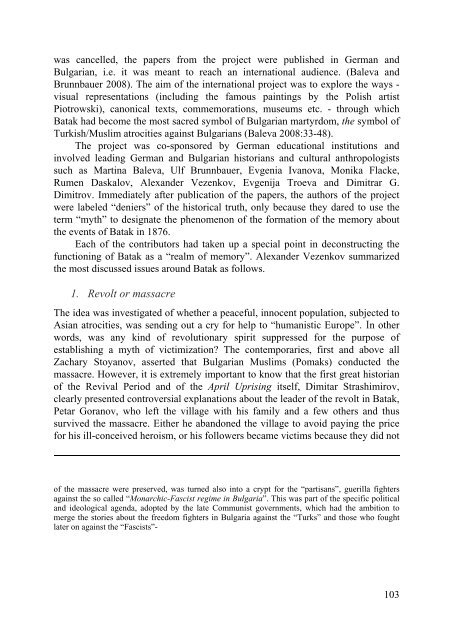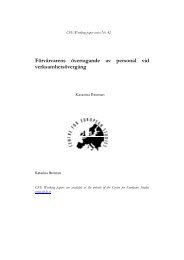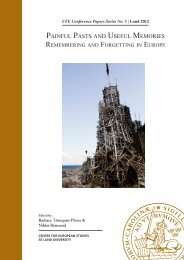MINNE OCH MANIPULATION - Centre for European Studies - Lunds ...
MINNE OCH MANIPULATION - Centre for European Studies - Lunds ...
MINNE OCH MANIPULATION - Centre for European Studies - Lunds ...
Create successful ePaper yourself
Turn your PDF publications into a flip-book with our unique Google optimized e-Paper software.
was cancelled, the papers from the project were published in German and<br />
Bulgarian, i.e. it was meant to reach an international audience. (Baleva and<br />
Brunnbauer 2008). The aim of the international project was to explore the ways -<br />
visual representations (including the famous paintings by the Polish artist<br />
Piotrowski), canonical texts, commemorations, museums etc. - through which<br />
Batak had become the most sacred symbol of Bulgarian martyrdom, the symbol of<br />
Turkish/Muslim atrocities against Bulgarians (Baleva 2008:33-48).<br />
The project was co-sponsored by German educational institutions and<br />
involved leading German and Bulgarian historians and cultural anthropologists<br />
such as Martina Baleva, Ulf Brunnbauer, Evgenia Ivanova, Monika Flacke,<br />
Rumen Daskalov, Alexander Vezenkov, Evgenija Troeva and Dimitrar G.<br />
Dimitrov. Immediately after publication of the papers, the authors of the project<br />
were labeled “deniers” of the historical truth, only because they dared to use the<br />
term “myth” to designate the phenomenon of the <strong>for</strong>mation of the memory about<br />
the events of Batak in 1876.<br />
Each of the contributors had taken up a special point in deconstructing the<br />
functioning of Batak as a “realm of memory”. Alexander Vezenkov summarized<br />
the most discussed issues around Batak as follows.<br />
1. Revolt or massacre<br />
The idea was investigated of whether a peaceful, innocent population, subjected to<br />
Asian atrocities, was sending out a cry <strong>for</strong> help to “humanistic Europe”. In other<br />
words, was any kind of revolutionary spirit suppressed <strong>for</strong> the purpose of<br />
establishing a myth of victimization? The contemporaries, first and above all<br />
Zachary Stoyanov, asserted that Bulgarian Muslims (Pomaks) conducted the<br />
massacre. However, it is extremely important to know that the first great historian<br />
of the Revival Period and of the April Uprising itself, Dimitar Strashimirov,<br />
clearly presented controversial explanations about the leader of the revolt in Batak,<br />
Petar Goranov, who left the village with his family and a few others and thus<br />
survived the massacre. Either he abandoned the village to avoid paying the price<br />
<strong>for</strong> his ill-conceived heroism, or his followers became victims because they did not<br />
of the massacre were preserved, was turned also into a crypt <strong>for</strong> the “partisans”, guerilla fighters<br />
against the so called “Monarchic-Fascist regime in Bulgaria”. This was part of the specific political<br />
and ideological agenda, adopted by the late Communist governments, which had the ambition to<br />
merge the stories about the freedom fighters in Bulgaria against the “Turks” and those who fought<br />
later on against the “Fascists”-<br />
103




